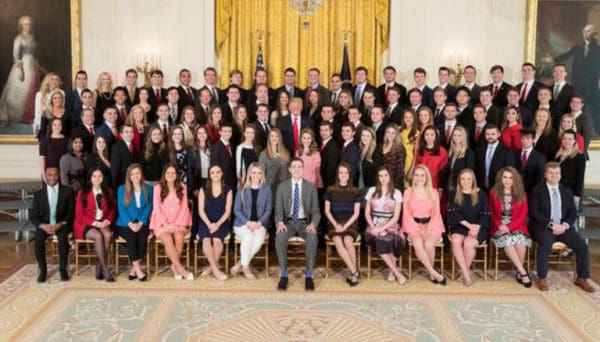The Whiteness of Trump’s White House Interns Is Absurd … And Speaks Volumes
Ruth Ben-Ghiat, CNN, April 3, 2018
Is this America’s new face to the world? Ninety-one proud new White House interns face the camera, with their beaming new boss, President Donald Trump, in the center. These shining faces, shown in a photo the White House released Friday of the 2018 Spring cohort, are very much “his” interns: Startlingly, it appears that all but two of them are white.
Is it accidental or intentional that the young man and woman of color are posed at the group’s edges, creating an unbroken show of racial homogeneity? And does the whiteness of the interns reflect willful culling or just self-selection, with black and brown potential candidates opting not to apply to work in this White House?
If the latter, the literal marginalization of people of color in this photo offers a visual explanation: It dovetails with the rhetoric and actions of the Trump administration.
{snip}
In fact, as a representation of American millennials (the demographic that White House interns belong to), this photograph is a fantasy. According to a recent Brookings Institution study, that generation is now 44% minority and “the most diverse adult generation in American history.” According to the 2015 census, whites were only 55.8% of the 18-34 age bracket, followed by Hispanic, black, Asian, and other groups.
{snip}
No wonder the Republican Party, whose voters are overwhelmingly white, has invested so much energy and media time in racially tinged visual and verbal propaganda. House Speaker Paul Ryan posted a very similar intern photo on social media at the 2016 Republican National Convention, and how many scenes of crowds of white males acclaiming Trump in the White House power sanctuary have we seen since the inauguration?
{snip}
The intern photo also raises another key question: Who will be welcome in the future to serve in the United States government? White House internships have long been launching pads into politics and eventual federal government service. What message does such a monochromatic image like this send to nonwhite young people who wish to embark on a career of civil service?
{snip}
Yet Trump’s quest to politicize government institutions also depends on “passive purges” — as when people remove themselves from government service (the hundreds who have left the Department of State, for example) or who no longer try to enter, doing the leader’s job for him. Many may feel unwanted in government for reasons of identity — not just people of color, but non-Christians and those in the LBGTQ population.
{snip}
















